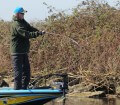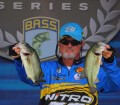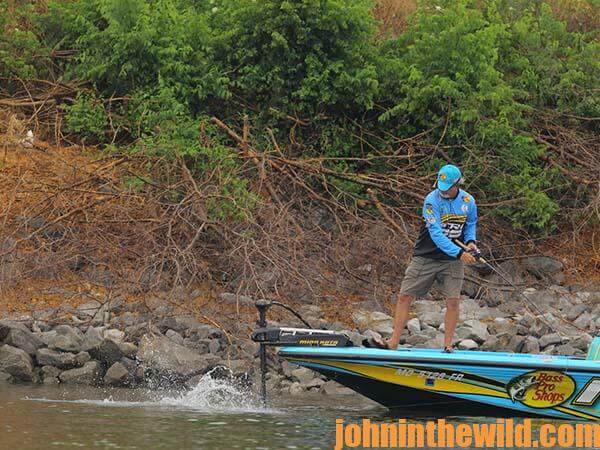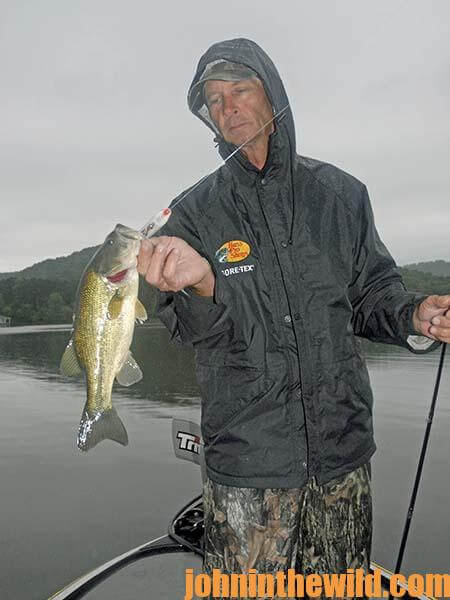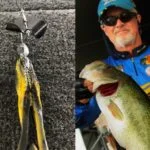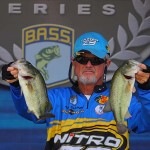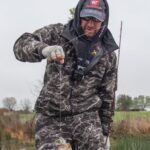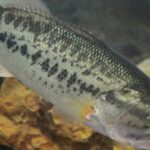John’s Note: This year 2013 anglers have experienced about every type of bad weather affecting much of the nation, particularly rain, floods and rising water. Outdoor writer John E. Phillips has talked with some of the tried-and-true bass fishermen who must catch fish no matter what the weather is. Rick Clunn www.rickclunn.com, a professional bass fisherman from Ava, Missouri, has won the Bassmaster Classic tournament 4 times, tying him with Kevin VanDam for most wins, and has been Angler of the year. Clunn is considered one of the best anglers of all time, having placed in the top 10 in over 100 tournaments and winning 17 of those. Clunn also has been inducted into the Bass Hall of Fame. Here are some of Rick Clunn’s tactics for finding bass in falling waters.
Run the Rip-Rap or Look for Trapped Fish: 
“An easy place to find bass on falling water is along rip-rap,” Rick Clunn reports. “If you have been catching bass on rip-rap before the water starts to fall, those same fish will stay on the rip-rap. However, they will be moving further out on the rocks into deeper water. The best way to locate these fish is with a depth finder. They can be found and caught. One region that is almost a sure bet when the water is falling if you can locate it is what I call a trapped-fish area. In many reservoirs where you locate a major tributary coming into a lake, there may be a sandbar at the mouth of that creek. For years, this area may have silted-up in the mouth of this creek. The water depth under normal conditions may be 5-feet deep. But, when the water is down, that sandbar may be only 1-foot under water. That shallow water may extend for a mile or two up the creek. Then just behind that sandbar there may be a 15-foot deep channel that runs several miles. If the water has been down for several weeks, then few anglers, if any, will cross that shallow flat to try and catch the bass in the deep channel on the other side. There has been little or no fishing pressure on those bass. Also because the mouth of the creek is blocked, most of the baitfish in the trapped area already may have been eaten by the bass. The bass in a trapped region should be extremely aggressive and easy to catch. However, a fisherman must know what he’s doing with his boat to go after these bass. I have seen many tournaments won by anglers who get their boats up on-plane and fly across sand flats to get to those hidden bass. But you are gambling when you go after those fish. If you win, you can catch plenty of good bass. However, if you lose, you may be sitting high and dry on a mud flat waiting for someone to come and help you get off. The weekend fisherman may want to use a small, lightweight boat to float the flats and get to those trapped fish. Remember, the longer the bass have been trapped, the better fishing you will have.”
Locate Areas Away from Pressure: 
“One of the best ways to catch bass during falling water or at any time of year is to pinpoint a place away from a pressure zone,” Clunn says. “I believe bass feel pressure from anglers. For instance, if there is a bush on a bank that is cast to by anglers 6 days a week, then that bush is a pressure zone. The bass in that bush will move deeper into the bush, and the strike zone will be much smaller than it will be for that same bass in the same bush in an area with fewer fishermen.
To catch the bass in the bush in a high-pressure section of the lake, your bait must penetrate the heart of the bush, which is why flipping has been so effective on many lakes. When flipping, the anglers go straight to the heart of the cover in high-pressure regions and catch bass. But, the easiest bass to take is the bass not found in the pressure zone. One thing you have to remember about falling water is not only does the lack of water concentrate the bass – it also concentrates the anglers. To be successful in low water, you must look for regions where the fishing pressure will be the lightest.
“An excellent way to do this is to study a lake map. From the map, you will choose where you will want to fish. Those areas probably will be where anglers most often plan to fish. Go back, and try and locate spots that may be marginal choices. These locations may have creek channels in them, but for some reason most anglers may not want to fish them. These places may include trapped-fish areas, rocky regions, visible old dam sites or hard-to-find creek channels in the middle of the lake. These waters usually will have the least amount of fishing pressure and the most-aggressive bass and be the hardest to reach. Your research will pay-off in better bass dividends. After you have worked out your map game plan to avoid the pressure areas, ride the lake for awhile. See if the pressure is in fact where you think it is. Go to those hard-to-get-to-places. The bass most often will be there, and the other boats won’t.
The advantage you have to fishing falling water is that you know where the bass will be. If you avoid the pressure zones and use the tactics and baits described, falling water may prove to be the best water condition you can fish. I know I’d rather fish falling water, and maybe you will too.
To get “Hot-Weather Bass Tactics,” “How to Become a Tournament Bass Fisherman,” “How to Win a Bass Tournament: Personal Lessons from 8 Pro Bass Fishermen,” “Catch the Most and Biggest Bass in Any Lake: 18 Pro Fishermen’s Best Tactics” and “How to Bass Fish Like a Pro,” click here to get these books.
About the Author
John Phillips, winner of the 2012 Homer Circle Fishing Award for outstanding fishing writer by the American Sportfishing Association (AMA) and the Professional Outdoor Media Association (POMA), the 2008 Crossbow Communicator of the year and the 2007 Legendary Communicator chosen for induction into the National Fresh Water Hall of Fame, is a freelance writer (over 6,000 magazine articles for about 100 magazines and several thousand newspaper columns published), magazine editor, photographer for print media as well as industry catalogues (over 25,000 photos published), lecturer, outdoor consultant, marketing consultant, book author and daily internet content provider with an overview of the outdoors. Click here for more information and a list of all the books available from John E. Phillips.

